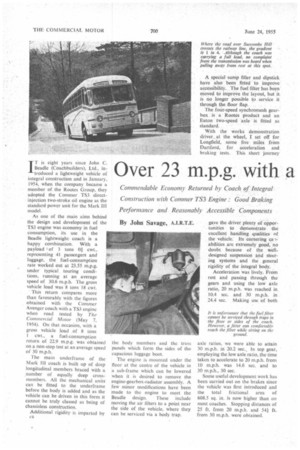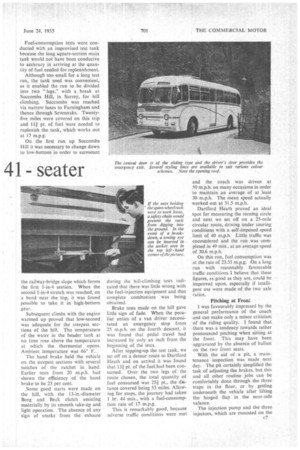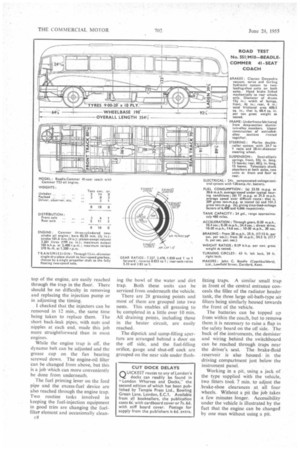Over 23 m.p.g. with a
Page 46

Page 47

Page 48

If you've noticed an error in this article please click here to report it so we can fix it.
41 seater Commendable Economy Returned by Coach of Integral Construction with Commer TS3 Engine : Good Braking Performance and Reasonably Accessible Components By John Savage, A.I.R.T.E. IT is eight years since John C. Beadle (Coachbuilders), Ltd., introduced a lightweight vehicle of integral construction and in January, 1954, when the company became a member of the Rootes Group, they adopted the Commer TS3 directinjection two-stroke oil engine as the standard power unit for the Mark HI model.
As one of the main aims behind the design and development of the TS3 engine was economy in fuel consumption, its use in the Beadle lightweight coach is a happy combination. With a payload i of 3 tons 0i cwt., representing 41 passengers and luggage, the fuel-consumption rate worked out at 23.55 m.p.g. under typical touring conditions, running at an average speed of 30.6 m.p.h. The gross vehicle load was 8 tons 18 cwt.
This return compares more than favourably with the figures obtained with the Commer Avenger coach with a TS3 engine when road tested by The Commercial Motor (May 7.
1954). On that occasion, with a gross vehicle load of 8 tons 1 cwt., a fuel-consumption return of 22.9 m.p.g. was obtained on a non-stop test at an average speed of 30 m.p.h.
The main underframe of the Mark ill coach is built up of deep longitudinal members braced with a .number of equally deep crossmembers. All the mechanical units can be fitted to the underframe before the body is added and as the vehicle can be driven in this form it cannot be truly classed as being of chassisless construction.
Additional rigidity is imparted by co the body members and the truss panels which form the sides of the capacious luggage boot.
The engine is mounted under the floor at the centre of the vehicle in a sub-frame which can be lowered when it is desired to remove the engine-gearbox-radiator assembly. A few minor modifications have been made to the engine to meet the Beadle design. These include moving the air filters to a point near the side of the vehicle, where they can be serviced via a body trap. A special sump filler and dipstick have also been fitted to improve accessibility. The fuel filter has been moved to improve the layout, but it is no longer possible to service it through the floor flap.
The four-speed synchromesh gearbox is a Rootis product and an Eaton two-speed 'axle is fitted as standard.
With the works demonstration driver,, at the wheel, I set off for Longfield, some five miles from Dartford, for acceleration and braking tests. This short journey gave the driver plenty of opportunities to demonstrate the excellent handling qualities of the vehicle. Its cornering calabilities are extremely good, no doubt because of the welldesigned suspension and steering systems and the general rigidity of the integral body.
Acceleration was lively. From rest and passing through the gears and using the low axle ratio, 20 m.p.h. was reached in 10.4 sec. and 30 m.p.h. in 24.4 sec. Making use of both axle ratios, we were able to attain 30 m.p.h. in 20.2 sec., In top gear, employing the low axle ratio, the time taken to accelerate to 20 m.p.h. from 10 m.p.h. was 14.6 sec. and to 30 m.p.h., 30 sec.
Some useful development work has been carried out on the brakes since the vehicle was first introduced and the total frictional area of 608.5 sq. in. is now 'higher than on most coaches. Stopping distances of 25 ft. from 20 m.p.h. and 54f ft. from 30 m.p.h. were obtained. Fuel-consumption tests were conducted with an improvised test tank because the long square-section main tank would not have been conducive to accitracy in arriving at the quantity of fuel needed for replenishment.
Although too small for a long test run, the tank used was convenient, as it enabled the run to be divided into two 'legs," with a break at Succombs Hill, in Surrey, for hill
Succombs was reached via narrow lanes to Farningham and thence through Sevenoaks. Twentyfive miles were covered on this trip and 11i pt. of fuel were needed to replenish the tank, which works out at 17 m.p.g.
On the first run up Succombs Hill it was necessary to change down to low-bottom in order to surmount the railway-bridge slope which forms the first 1-in-4 section. When the second 1-in-4 stretch was reached, on a bend near the top, it was found possible to take it in high-bottom gear.
Subsequent climbs with the engine warmed up proved that low-second was adequate for the steepest sections of the hill. The temperature of the water in the header tank at no time rose above the temperature at which the thermostat opens. Ambient temperature was 66° F
The hand brake held the vehie:e on the steepest sections with several notches of the ratchet in hand. Earlier tests from 20 m.p.h. had shown the efficiency of the hand brake to be 23 per cent.
Some good starts were made on the hill, with the 13-in.-diameter Borg and Beck clutch assisting materially by its smooth take-up and light operation. The absence of any sign of smoke from the exhaust during the hill-climbing tests indicated that there was little wrong with the fuel-injection equipment and that complete combustion was being obtained.
Brake tests made on the hill gave little sign of fade. When the peculiar antics of a van driver necessitated an emergency stop from 25 m.p.h. on the fourth descent, it was found that pedal travel had increased by only an inch from the beginning of the tests.
After topping-up the test tank, we set off on a detour route to Dartford Heath and on arrival it was found that 13f pt. of the fuel had been consumed. Over the two legs of the route chosen, the total quantity of fuel consumed was 25i pt., the distance covered being 53 miles. Allowing for stops, the journey had taken 1 hr. 44 min.. with a fuel-consumption rate of 17m.p.g.
This is remarkably good, because adverse traffic conditions were met and the coach was driven at 50 m.p.h. on many occasions in order to maintain an average of at least 30 m.p.h. The mean speed actually worked out at 31.5 m.p.h.
Dartford Heath proved an ideal spot for measuring the turning circle and next we set off on a 25-mile circular route, driving under touring conditions with a self-imposed speed limit of 40 m.p.h. Little traffic was encountered and the run was completed in 49 min., at an average speed of 30.6 m.p.h.
On this run, fuel consumption was at the rate of 23.55 m.p.g. On a long run with reasonably favourable traffic conditions I believe that these figures, as'good as they are, could be improved upon, especially if intelligent use were made of the two axle ratios.
Pitching at Front I was favourably impressed by the general performance of the coach and can make only a minor criticism of the riding quality. I found that there was a tendency towards rather pronounced pitching when sitting at the front. This may have been aggravated by the absence of ballast on the two front seats.
With the aid of a pit, a maintenance inspection was made next day. The pit certainly simplified the task of adjusting the brakes, but this and all other routine jobs can be comfortably done through the three traps in the floor, or by getting underneath the vehicle after lifting the hinged flap in the near-side valance.
The injection pump and the three injectors, which are mounted on the c7 top of the engine. are easily reached through the trap in the floor. There should be no difficulty in removing and replacing the injection pump or in adjusting the timing.
1 checked that the injectors can he removed in 12 min., the same time being taken to replace them. The short back-leak pipes, with nuts and nipples at each end, made this job more straightforward than in most engines.
While the engine trap is off, the dynamo belt can be adjusted and the grease cup on the fan bearing screwed down. The engine-oil filter can he changed from above, but this is a job -which can more conveniently be done from underneath.
The fuel priming lever on the feed pipe and the excess-fuel device are also reached through the engine trap. Two routine tasks involved in keeping the fuel-injection equipment in good trim are changing the fuelfilter element and occasionally clean c8 ing the bowl of the water and dirt. trap. Both these units can be serviced from underneath the vehicle.
There are 28 greasing points and most of them are grouped into two nests. "rhis enables all greasing to be completed in a little over 10 min. All draining points, including those in the heater circuit, arc easily reached.
The dipstick and sump-filling aperture are arranged behind a door on the off side, and the fuel-filling orifice, gauge and shut-off cock are grouped on the near side under flush
fitting traps. A similar small trap in front of the central entrance conceals the filler of the radiator header tank, the three large oil-bath-type air filters being similarly housed towards the front of the vehicle.
The batteries can be topped up from within the coach, but to remove them it is necessary to raise a flap in the safety board on the off side. The back of the instruments, the demister and wiring behind the switchboard can be reached through traps near the driver's seat. The brake-fluid reservoir is also housed in the driving compartment just below the instrument panel.
Working M a pit, using a jack of the type supplied with the vehicle, two fitters took 7 mm. to adjust the brake-shoe clearances at all four wheels. Without a pit the job takes a few minutes longer. Accessibility under the vehicle is illustrated by the fact that the engine can be changed by one roan without using a pit.








































































































